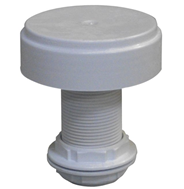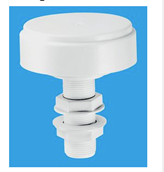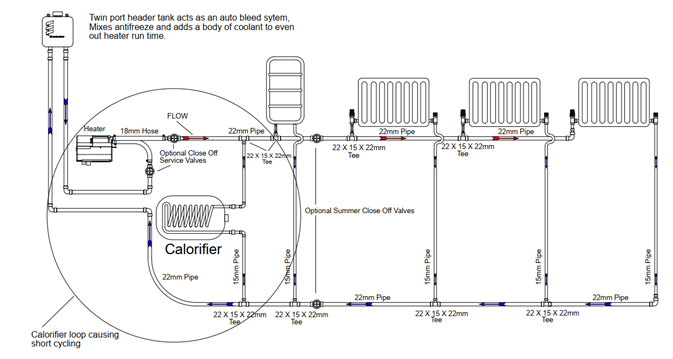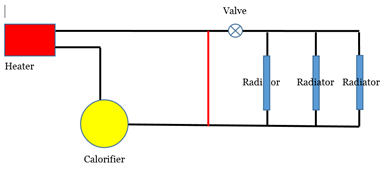

RickS
Member-
Posts
333 -
Joined
-
Last visited
Content Type
Profiles
Forums
Events
Gallery
Blogs
Store
Everything posted by RickS
-
Sorry to bump this back up again, but went to the boat yesterday to measure the pipe. What i thought was a metal tube is, on closer inspection, a piece of yellow rubber(?) 3/4" gas pipe painted grey with deck paint and you can see where filler has been used around it to secure it to the deck. Seems like a right bodge but probably a massive pain to change. I assume that the precviously suggested solutions to cap it off would still work with a rubber hose?
-
Thanks Tracy, I'm still being a bit dense, but won't the elbow part still allow access to the tank to insects as it is only the top that is screened?
-
Thanks MartynG, that's very helpful. Not 100% sure how to fix it to the pipe yet, but hopefully will know more when I measure it on Weds. I did think of some sort of compression fitting, but again this would depend on size and whether it is compatible with the vent you have linked to
-
-
Thanks Tracy, but I'm not sure the pipe sticks out far enough from the deck floor to make the U-bend pipe workable (not 100% about this as I will need to measure to be sure) and the breather in the kit is the second picture in my post above. The third part of the kit looks open rather than having a mesh of some sort in it. Maybe it has, do you know?
-
That's a good idea David, I'll look into that. I have seen these which I assume I can fix onto or into the pipe, itdepends on the internal and outside diameters, which Jen asked me about. Both of these are 3/4 " so when I get back to the boat I can measure the pipe. These would seem to be suitable?
-
Thanks for the replies. Very creative Tracy! Jen - Pretty sure the tube is steel, not sure of the OD, didn't think to check, thought they might be standard size. It's certainly less than an inch. I will check and get back when I go to the boat after the weekend.
-
Afternoon all I have a breather tube from the water tank sticking up about 2 inches from the front deck. It has been suggested that I cover it to stop foreign bodies dropping in - nice. My first thought was something like a bit of nylon mesh (tights?) and an elastic band, but that seems a bit crude. is there something you would recommend please? Thanks
-
Thanks Tony I had read somewhere about it being possibly life-shortening for a diesel heater to keep switching on and off, and how it was better to just turn it on, heat up a tank of water then turn it off. Then only turning it back on when the tank had run out. This sounded sensible and uncomplicated and i thought that this would be the way I would use it. Sounds like I don't have to worry so much about the heat dump, but I will talk it through with whomever installs it. I'm not that kind of bloke to hold someone accountable for their freely given advice ? - which I am extremely grateful for. If I was paying you and it exploded, well that's another thing ? I will have to find some domestic plumbing books and read up on balancing - I think I understand it in principle, but not in any great depth. As I say, it won't be me installing it but I suspect it would be a good thing to have at least a basic knowledge of it - that said, I know very little about the plumbing in my house so that's a bit hypocritical of me ? Thanks again
-
Thanks Tony I had looked at an installation diagram from Everspacher before I started asking questions about installation, and even thought I understood it! After looking at my drawing and reading the replies to my post, I don't think I did. Looking at Eberspacher's diagram in the light of the posts and your diagram David Mack, thankyou, it makes more sense now. I was confused slightly by earlier posts, one of which said that they leave a rad/towel rail on and then a subsequent one which said there was no need to. Apologies if I have used those posts slightly out of context. So this would mean I would need to leave some sort of heat dump (rad or towel rail) on even when the other radiators have been valved off ? In your drawing David Mack, there is a red line returning from the coil in the calorifier to the heater - is that essentially doing the same job as the towel rail in the diagram above ? My system, or so I believe, does not have this heat dump radiator - I suppose to be 100% certain about that I need to know if and where the radiator shut off valves are. So if I have turned off pressumably present valves to the radiator system, if I want to use the heater to heat a tank of hot water, i have to have a rad left on before the valves whilst it is heating the calorifier? Thanks again Tony and David
-
Balancing valve yes (although I have to read up more on this) but I am assuming when you say heat dump radiator you mean the heater just treats the red line as if there is a radiator on it, or do you mean there should be an actual rad / towel rail there? If so, then I presumably would have to treat the first rad in my system as that heat dump and put shutoff valves between that one and the rest of the rads? Wish I was a plumber!
-
Actually Tony, I can't lie, I originally drew the heater output as the top line, but thinking about it, that doesn't make sense does it, as it has to go to the calorifier first? So, yes, the bottom line is the output from the heater ? . When you say that the radiatiors get their share of the flow, would that be as simple (?) as making the furthest one away from the heater open fully, whilst the closer ones are progressively closed down more? I'm not sure what I've just said makes sense as the furthest one still gets its hot water after the radiator 'in front' of it. Balance valve ? - I am going to have do some more research on that, as I am not clear about what that means or entails Good point about it being essentially a small domestic system - I can look at non-boat literature Thanks again
-
I'm not really saying that's what my system is like as I'm not 100% sure. I'm just trying to understand some basic concepts so when my new heater is isntalled I'll know more what to ask for and what might need changing. I take your point about water taking the shorter path along the red line and the calorifier installed in front of the red line but similarly to the radiators. Two valves makes sense, if I'm understanding it correctly - the Eberspacher literature show a similar but more detailed diagram that has a regulator valve on the red line - which I don't pretend to understand
-
Thanks Tony I'm not 100% sure what you mean even though I'm sure you expressed it in simple terms - shows my level of knowledge Rather than try to convey what I understand you to mean in writing, I have drawn it out Is the red line the part of the circuit you mean by connected by Ts? I assume you are referring to T-shape copper joints? Apologies for appearing so dense but when it comes to plumbing, I'm afraid I am! So the red line would, as you say, be jsut another rad / towel rail to the heater? I have left out any expansion tanks and ergulator valves for clarity. I have no idea about the regulation side of it - I know that I will be getting someone else to fit the heater, but I think it's important to have a grasp of whats going on in the boat Any books / website you recommend to learn more about this please? Ta
-
I have been reading the Eberspacher literature and the whole short cycling aspect of using the heater is starting sink in (I think). I understand turning off the radiators in summer and best use of the heater to just heat water is to heat the calorifier then turn off the heater to avoid cycling. What I'm struggling a bit with is having a radiator or towel rail without a turnoff valve to create a larger circuit and is kept on during summer (is that right?) and the whole process of regulating the flow, with a valve. the regulating I presume i can learn or maybe that is set initially and then left? But the towel rail as a larger circuit I'm not sure about. I think this was spoken about earlier - the first radiator in the system is in the bedroom - I don't see how, if the heating circuit is turned off in summer, anything other than the first one can be used in this way - but, as I say, I'm struggling with it.
-
Thanks again all. Markinaboat, I'm afraid a lot of the technical info went above my head so if you did answer that I failed to see it, but I'm sure you did, and thank you. Presumably the one radiator left on for safety would be as a sort of pressure relief? If I shut off the rads and fire up the diesel heater would it not start to heat the radiator system via the hot water tank anyway? You can tell i know sod all about these systems!
-
Thanks to all who have replied with their help and advice. I think I shall be going down the Eberspacher route. Sorry to crowbar this into this thread, but can the diesel heater be used to heat the hot water tank without heating the radiators? In the Summer obviously won't be needing the rads but is running the engine the only way to get hot water? I was just wondering what happens when you are moored up for a few days Thanks again
-
Thanks Tracy - I don't have the knowledge to analyse / fix the problem, but someone is going to look at it next week, but he was one of the people who won't really go much beyond a glo-plug issue. I will pass on what you have said about the relay.
-
No idea if I have to replace exhaust system - would changing from the Mikuni to Ebersapcher/Webasto mean I have to? Thanks for the link A lot of the spares seem out of stock, but only really going on what I was told, obsolete model (?) no spares etc etc
-
I have a Mikuni MX40 which has packed up. Not sure if it's serious or not but the two people I have spoken to about both said that if it isn't the glo-plug they can't/won't work on it as spares are virtually impossible to get hold of. It would seem that getting it serviced(if possible) may be throwing good money after bad - Nature's way of telling me to replace it? I would appreciate any recommendations as to make / model and a ball-park figure for supply and fit (if known). Thanks all
-
Thanks all. I think I will go with the Excellence for the time being - just because I need to get one and am baulking at the thought of lashing out nearly £500 - but definitely keeping that as an option. Appreciate everyone's input - possibly not the best term in a post about toilets !
-
Thanks Bill So buying two to get the spare cassete would mean you had a spare top half? would you keep that for spare parts? Thanks for the replies everyone. Annoyingly, when I got the boat there was a new portpotti, which I promptly sold 'I won't be needing that!' I thought. That'll teach me. Interesting that no-one has any real negatives about either model/type, which is good, so I'll have to start shopping around now and see exactly what costs what. Thanks again
-
Not sure whether this post should be here or in Boat Equipment. I am new to boating and was pleased to see that composting toilets were a viable option, or so I thought. I have been following the lengthy couple of threads about disposal of waste from a composting loo, which at times were informative, challenging, a bit silly and downright hostile. I am now rethinking my choice until I have a suitable place to compost it properly, but now have to get another toilet. Having shelled out the best part of £400 for the composting one, i don't really want to spend that much again unless I have to. I have narrowed my choices to a Thetford cassette (can't remember the exact model C240 ?) which has a manual flush and fill. I would rather this option as it simplifies the installation and reduces risk of mistakes. The other choice is the Thetford Excellence - considerbly cheaper and seems to tick all the boxes. I would be grateful for any pros and cons for either model please (or, indeed, any other model you know about) Ta
-
Definitely going to replace the sockets with 12V / 5V specific ones - although dont have any 12V appliances, mainly for USB. Still not understanding why square-pin sockets were connected to the 12V supply (assuming they were) - maybe overthinking that bit
-
Thank you to everyone who posted a reply - apologies for not naming you all. Although I don't understand a lot of some of the answers, I still think I have learned something - if only to get someone in to explain it to me ? I think I am using terminology incorrectly that is either confusing the issue or engendering answers that are confusing me! I am in a marina – to be honest I haven’t tried other avenues, I hoped the problem would be simple or obvious but it seems it isn’t, or at least it might be, but without wiring diagrams or a better explanation from me, it is unreasonable for me to expect you guys to work blind, as it were. As pete.i, Graham Davis, PD1964 and The Happy Nomad have pointed out (and probably everyone else thought) I think my best plan is to get someone in to have a look and explain it to me. PD1964 Did you get the boat surveyed before purchase? Yes, and have just re-read the section about electrics ‘There are several square pin sockets, (the type used for 230volt) fitted in the saloon area, these are labelled as 12volt. The surveyor can confirm that they are not connected to the 230volt supply, however it cannot be confirmed if they are connected to the 12volt supply’ I suspect I have been a bit of a dick about this – I clearly hadn’t taken this in when I first got the survey report. Although still not sure whether they are supplying 12V and why they are square-pin sockets I understand those who have expressed concern at my level of knowledge – I agree with you and won’t be taking risks – although will try to meter the sockets. Thanks again






